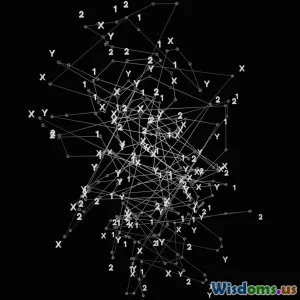
From Raw Data to ANOVA: A Step by Step Journey
15 min read A practical guide to transforming raw data for ANOVA analysis through clear, actionable steps. (0 Reviews)
From Raw Data to ANOVA: A Step by Step Journey
Unveiling the story hidden in raw data is the hallmark of insightful analytics. While numbers alone only hint at underlying patterns, statistical methods like ANOVA (Analysis of Variance) enable researchers and professionals to answer meaningful questions with confidence. Whether you're comparing patient recovery rates across treatments, evaluating customer satisfaction for different branches, or optimizing agricultural yields, ANOVA stands as a vital gateway from mere observation to robust inference.
In this guide, let's walk through the journey from collecting unstructured data all the way to drawing clear conclusions using ANOVA. You'll grasp the critical steps, practical tips, and common pitfalls at each milestone—arming you to make evidence-based decisions, not just educated guesses.
Understanding the Raw Data Landscape

Raw data is the unrefined foundation of all analyses. Imagine a dataset freshly exported from a hospital information system: patient IDs, treatment groups, outcome measures, maybe even missing fields. It's chaotic, unclean, and yet bursting with potential.
Concrete Example: Survey Responses
Suppose you're tasked with analyzing the effectiveness of three teaching methods. Every student in a school completes a quiz after attending one method. Their raw scores, grouped by which method each attended, are your starting dataset. Here’s what the data table might look like:
| Student_ID | Method | Score |
|---|---|---|
| 1 | Interactive | 78 |
| 2 | Lecture | 68 |
| 3 | Online | 74 |
| … | … | … |
Actionable Advice:
- Preserve data integrity; avoid manual tampering in raw phase.
- Save files in standardized formats like CSV or XLSX.
- Document the source, collection date, and variable meanings.
Pitfalls:
- Missing documentation or unconventional abbreviations can render data difficult, or impossible, to analyze later.
- Not tracking units (e.g., minutes versus hours) can introduce critical errors downstream.
Preparing and Cleaning Data

Before any meaningful analysis, raw data requires rigorous cleaning. This stage ensures accuracy, reliability, and readiness for subsequent statistical techniques, especially ANOVA, which is sensitive to outliers, missing values, and erroneous entries.
Data Cleaning Steps:
-
Identify and Handle Missing Values
For instance, if any student didn't attend the quiz, mark their row, and decide: exclude or impute? -
Detect and Correct Outliers
Scores like 0 or 110 (when the quiz is out of 100) should trigger scrutiny. -
Standardize Categories
Ensure "interactive", "Interactive", and "INT" represent the same teaching method. -
Remove Duplicates
Accidentally entered records can skew comparative analyses hopelessly.
Example with Python:
import pandas as pd
df = pd.read_csv('quiz_scores.csv')
# Check missing values
print(df.isnull().sum())
# Remove duplicates
df = df.drop_duplicates()
# Fix inconsistent labels
df['Method'] = df['Method'].str.capitalize()
Key Takeaway: Cleaning is often 60–80% of the entire analytics process. Compromising here weakens everything that follows.
Structuring Data for ANOVA

Not all data formats are ready for ANOVA. Usually, ANOVA (especially one-way) demands a clear categorical group variable and a numerical dependent variable. Preparing data structure properly avoids costly reruns and failed tests.
Example:
To compare means across teaching methods, data should resemble:
| Method | Score |
|---|---|
| Interactive | 78 |
| Lecture | 68 |
| Online | 74 |
You don't need separate columns for each group—long format (above) is preferred for statistical libraries in R, Python, and SPSS.
Tips:
- Ensure your grouping variable is categorical ('Lecture', 'Online', etc.), not numeric codes without documentation.
- Check that each group has an adequate sample size; extremely small groups undermine statistical power.
- Use exploratory data analysis (box plots, histograms) to visualize distributions and spot inconsistencies.
Pitfall: Attempting ANOVA with improperly structured data—like wide-format sheets or mixed-typed variables—leads to syntax errors, messy output, and unreliable results.
Assessing Assumptions Before Analysis

ANOVA’s power hinges on certain assumptions about your data. Ignoring these guards can yield misleading conclusions.
The Three Core Assumptions
- Independence: Observations in each group must be independent. In our quiz example, one student's performance shouldn't affect another's.
- Normality: Scores within each group should follow a normal (bell curve) distribution.
- Homogeneity of variances: Each group’s scores should have similar spread (variance).
How to Test Assumptions
- Normality: Employ Shapiro-Wilk test (or Kolmogorov-Smirnov if sample is large) for each group. Visual inspection via Q-Q plots helps.
- Homogeneity: Levene’s test (widely used; robust to non-normality). A high p-value supports the assumption.
- Independence: Typically baked into study design (random assignments).
Practical Application with Python:
from scipy import stats
# Normality
for method in df['Method'].unique():
print(stats.shapiro(df[df['Method'] == method]['Score']))
# Variance homogeneity
from scipy.stats import levene
groups = [df[df['Method']==m]['Score'] for m in df['Method'].unique()]
print(levene(*groups))
Why it matters: By validating assumptions upfront you'll either proceed, adapt your method (e.g., use Kruskal-Wallis test if normality fails), or redesign your experiment—saving effort and credibility.
Conducting the One-Way ANOVA Test

With clean, well-structured data and satisfied assumptions, we proceed to the heart—the one-way ANOVA test. This technique determines if at least one group’s mean differs significantly from the others.
The Mechanics of ANOVA
The core idea: analyze variability between groups versus within groups. If the difference between groups dwarfs individual variability, it’s evidence that the group variable (say, teaching method) actually affects scores.
Mathematically:
- Between-group variance (MSB): Variance of group means from overall mean, weighted by group size.
- Within-group variance (MSW): Variability in scores within each group.
- F-statistic: Ratio of MSB to MSW. Higher F = more likely means differ truly, not by chance.
Example Calculation on Teaching Methods
Suppose the group means are:
- Interactive: 82
- Lecture: 69
- Online: 75
Variance within each group has been found. An F-statistic is calculated, and compared to a critical value from the F-distribution. If the resulting p-value < 0.05, the difference is considered significant.
Real-World Execution (Python):
from scipy.stats import f_oneway
f_val, p_val = f_oneway(
df[df['Method'] == 'Interactive']['Score'],
df[df['Method'] == 'Lecture']['Score'],
df[df['Method'] == 'Online']['Score']
)
print('F-statistic:', f_val, 'p-value:', p_val)
If p-value is 0.003—well below the typical significance level of 0.05—you have strong evidence teaching method impacts student outcomes!
Caveats:
- ANOVA tells if there's a difference, not where it lies.
- Doesn’t handle several independent variables (that’s for factorial or two-way ANOVA).
Traversing Post Hoc Analysis

A significant ANOVA result triggers a natural next question: which group means differ? This is where post hoc tests step in, guarding against "false positive" pairwise differences.
Common Post Hoc Tests
- Tukey’s Honest Significant Difference (HSD): Ideal when group sizes are equal.
- Bonferroni Correction: Simple, conservative; divides significance threshold by the number of comparisons.
- Scheffé’s Test: Used for unequal variances and larger set of combinations.
Python Implementation Example (Tukey HSD):
import statsmodels.stats.multicomp as mc
comp = mc.MultiComparison(df['Score'], df['Method'])
tukey_result = comp.tukeyhsd()
print(tukey_result)
Tukey’s HSD result might show:
| Comparison | Mean Diff | p-Value |
|---|---|---|
| Interactive-Lecture | 13.0 | <0.001 |
| Interactive-Online | 7.0 | 0.04 |
| Lecture-Online | 6.0 | 0.20 |
So, Interactive method significantly outperforms Lecture and Online, but Lecture vs. Online isn't significantly different.
Insights:
- Post hoc transparency is vital for actionable outcomes and reporting.
- Overusing post hoc tests inflates Type I error (false hope!), which is why corrections are applied.
Reporting and Visualizing Results

Statistical outcomes gain power when reported with clarity and compelling visuals. Stakeholders often need both the big picture and actionable detail.
Key Elements of a Report
- Summary Table: Means, standard deviations for each group.
- ANOVA Table: F-statistic, degrees of freedom, p-value.
- Post hoc Findings: Clear statement on which means differ.
Effective Visualization Techniques:
- Boxplots: Show full score distributions per group—outliers included.
- Bar Charts with Error Bars: Visualize group means plus confidence intervals.
- Annotated Results: Mark statistically significant differences with asterisks or connecting lines.
Example Visualization (Matplotlib in Python):
import matplotlib.pyplot as plt
import seaborn as sns
sns.boxplot(x='Method', y='Score', data=df)
plt.title('Distribution of Scores by Teaching Method')
plt.show()
Well-made visuals don't just beautify work—they anchor business proposals, scientific publications, and actionable conclusions.
Tip: Always accompany numerical p-values with easy-to-understand visuals for non-technical readers—it makes your insights accessible and powerful!
From Analysis to Action: Making Decisions Based on ANOVA

The power of ANOVA is realized fully when its results drive improved practices. Statistical significance alone is only half the equation—what matters is the practical, real-world implication.
- Educational Reform: If your analysis confirms "Interactive" teaching yields highest scores, consider reallocating resources to expand its implementation.
- Healthcare: If a new treatment outperforms control and existing therapies, it can justify broader clinical trials or updated patient protocols.
- Manufacturing: Identifying the most efficient process in a plant leads to cost savings and operational excellence.
Best Practices for Applying Findings:
- Align with Organizational Goals: Link ANOVA-backed recommendations to concrete outcomes (e.g., graduation rates, patient health, profit margins).
- Communicate Limitations: Be upfront about sample size limits, unmeasured confounders, and statistics-vs-practical difference.
- Suggest Next Steps: Sometimes, ANOVA answers one question but uncovers others—prompt further hypothesis and experimentation.
Case in Point: A retail chain's ANOVA reveals certain store layouts significantly boost sales. Management pilots the winning design across more locations, then re-evaluates quarterly—enacting a data-driven feedback loop.
Embracing this cycle—data cleaning, honest analysis, thorough reporting, and bold application—transforms raw numbers into a powerful narrative. Whether you’re optimizing resource allocation, improving patient outcomes, or simply striving to make better everyday decisions, the journey from raw data to ANOVA is your road to statistically-sound, strategically-brilliant action.
Rate the Post
User Reviews
Popular Posts

















